신생아의 식도 위장관 폐쇄의 각종 원인-환상췌장, 선천성 식도 폐쇄, 선천성 기관 식도 간 누관(식도 기관 샛길, 식도 기관 루), 비후성 유문 협착증, 장축염증, 선천성 거대결장, 태변성 장폐색증, 장중첩증, 서혜부 탈장 감돈, 무공항문(쇄항증), 장폐쇄증 등, Various causes of obstruction of esophagus and gastrointestinal tract in newborn infants
- 신생아의 식도에서 항문까지의 소화계의 일부분이나 대부분이 여러 가지의 원인으로 인해 여러 가지 형태로 막힐 수 있다.
- 즉 식도·위·십이지장·소장·대장·직장·항문 등의 일부분 또는 전 부분이 선천적으로, 또는 후천적으로 완전히 또는 불완전하게 막힐 수 있다. 즉 폐쇄될 수 있다.
- 환상췌장·선천성 식도폐쇄·선천성 기관 식도간 누관(식도 기관 누)·비후성 유문 협착증·장축염증·선천성 거대결장·태변성 장폐색증·장중첩증·서혜부 탈장 감돈·무공항문(쇄항증)·장폐쇄증 등으로 신생아의 식도나 위장관 등이 막힐 수 있다.
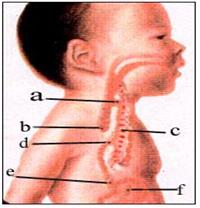
그림 2-193. 선천성 기관 식도 간 누관
a-기관 식도 누관(식도 기관 루), b-막힌 식도 위 부분, c-기관, d-막힌 식도의 아랫 부분, e-위
Used with permission from Ross Lab,Columbus.Ohio.USA와 소아가정간호백과
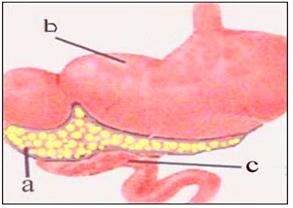
그림 2-194. 환상 췌장과 환상췌장으로 막힌 십이지장
a-환상 췌장의 앞 부분, b-확장된 십이지장관의 위부분과 위, c-십이지장의 하부
Used with permission from Ross Lab,Columbus.Ohio.USA와 소아가정간호백과
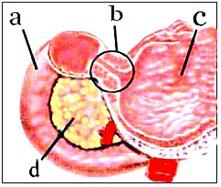
그림 2-195.유문 협착증
a-십이지장관, b-협착된 유문(여기서 유문 괄약근이 비대된 것을 볼 수 있다), c-위, d-췌장
출처; Used with permission from Ross Lab,Columbus.Ohio.USA와 소아가정간호백과
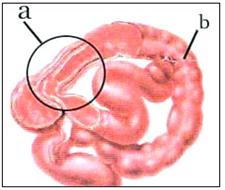
그림 2-196. 장중첩증
a-중첩된 장 부분, b-소장
출처; Used with permission from Ross Lab,Columbus.Ohio.USA와 소아가정간호백과
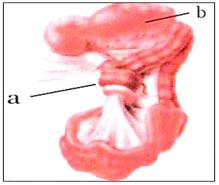
그림 2-197. 장축염증
a-꼬인 소장관의 부분, b-확장된 소장관의 부분
출처; Used with permission from Ross Lab,Columbus.Ohio.USA와 소아가정간호백과

그림 2-198. 선천성 거대 결장
a-소장관, b-확장된 결장관, c-비정상적 결장관, d-정상 상행 결장관
출처; Used with permission from Ross Lab,Columbus.Ohio.USA와 소아가정간호백과
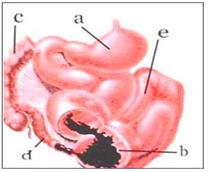
그림 2-199. 태변성 소장관 폐쇄증
a-위, b-태변으로 폐쇄된 소장관의 부분, c-대장(결장)관,
d-확장되지 않은 소장관, e-확장된 소장관의 부분
출처; Used with permission from Ross Lab, Columbus. Ohio. USA와 소아가정간호백과
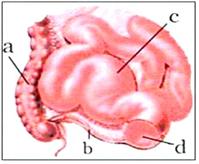
그림 2-200. 소장관 폐쇄증
a-폐쇄된 소장관 부분의 아래부위에 있는 대장(결장)관, b-폐쇄된 소장관 부분의 아랫 소장, c-폐쇄된 소장관의 부분의 윗 부위 소장(확장되어있다),
d-폐쇄된 소장관의 부분
출처; Used with permission from Ross Lab, Columbus. Ohio. USA와 소아가정간호백과
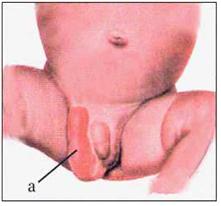
그림 2-201. 우 서혜부 탈장증(a)
출처; Used with permission from Ross Lab, Columbus. Ohio. USA와 소아가정간호백과
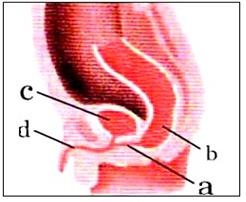
그림 2-202.무 항문증(쇄항증),
무 항문증에는 여러 형태가 있다
a-직장–요도 간 누관이 있는 무 항문증,
b-무 항문의 직장(확대됐다), c-방광, d-요도
(누관을 샛길, 루 또는 누공이라고도 한다)
출처; Used with permission from Ross Lab, Columbus. Ohio. USA와 소아가정간호백과
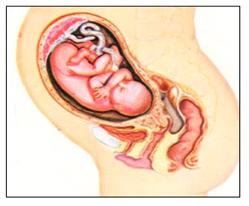
그림2-203.자궁강 내 태아의 체위
Copyright ⓒ 2012 John Sangwon Lee, MD., FAAP
Various causes of esophageal gastrointestinal obstruction in newborns – annular pancreas, congenital esophageal obstruction, congenital tracheal esophageal fistula (esophageal tracheostomy, esophageal tracheostomy), hypertrophic pyloric stenosis, intestinal inflammation, congenital megacolon, meconium ileus, intussusception, inguinal hernia Various causes of obstruction of esophagus and gastrointestinal tract in newborn infants
• Part or most of a newborn’s digestive system from the esophagus to the anus can be blocked in one way or another for a variety of reasons.
• That is, part or all of the esophagus, stomach, duodenum, small intestine, large intestine, rectum, and anus may be completely or incompletely blocked congenitally or acquired. That is, it can be closed.
• Annular pancreas
• Congenital esophageal obstruction
• Congenital interesophageal fistula (esophageal tracheal fistula)
• Hypertrophic pyloric stenosis
• Inflammation of the intestinal axis
• Congenital megacolon
• Meconium ileus
• Intussusception
• Inguinal hernia confinement
• Aortic anastomosis (atresia)
• Intestinal atresia/
This can cause blockage in the esophagus or gastrointestinal tract of the newborn.

Figure 2-193. Congenital trachea esophageal hepatic fistula
a – trachea esophageal fistula (esophageal fistula), b – obstructed upper part of the esophagus, c – trachea, d – obstructed lower part of the esophagus, e – stomach.
Used with permission from Ross Lab, Columbus.Ohio.USA and Encyclopedia of Pediatric and Family Nursing

Figure 2-194. Annular pancreas and duodenum obstructed by annular pancreas
a – the anterior part of the annular pancreas, b – the stomach and upper part of the dilated duodenum, c – the lower part of the duodenum. Used with permission from Ross Lab, Columbus.Ohio.USA and Encyclopedia of Pediatric and Family Nursing

Figure 2-195. Pylori Stenosis a-duodenal tract
.b-stenotic pylorus (here you can see an enlarged pyloric sphincter), c-stomach, d-pancreas. Source; Used with permission from Ross Lab, Columbus.Ohio.USA and Encyclopedia of Pediatric and Family Nursing

Figure 2-196. Intussusception.
a – nested part of the intestine, b – small intestine. Ssource; Used with permission from Ross Lab, Columbus.Ohio.USA and Encyclopedia of Pediatric and Family Nursing

Figure 2-197. Intestinal inflammation.
a – part of the twisted small intestine, b – part of the dilated small intestine. Source; Used with permission from Ross Lab, Columbus.Ohio. USA and Encyclopedia of Pediatric and Family Nursing

Figure 2-198. Congenital giant colon a-small intestine.
b-dilated colon, c-abnormal colon, d-normal ascending colon. Source; Used with permission from Ross Lab, Columbus.Ohio.USA and Encyclopedia of Pediatric and Family Nursing

Figure 2-199. Meconium small intestine atresia
a – stomach, b – part of the small intestine closed with meconium, c – the large intestine (colon) tube, d – undilated small intestine, e – part of the small intestine dilated. Source; Used with permission from Ross Lab, Columbus. Ohio. The USA and the Encyclopedia of Pediatric and Family Nursing

Figure 2-200. Small intestine atresia.
a – the large intestine (colon) duct in the lower part of the obstructed segment of the small intestine, b – the lower small intestine in the segment of the closed small intestine, c – the small intestine in the upper part of the obstructed segment of the small intestine (dilated); d – part of the closed small intestine. Source; Used with permission from Ross Lab, Columbus. Ohio. The USA and the Encyclopedia of Pediatric and Family Nursing

Figure 2-201. Right inguinal hernia (a). Source; Used with permission from Ross Lab, Columbus. Ohio. USA and the Encyclopedia of Pediatric and Family Nursing

Figure 2-202. Imperforate anus. There are several forms of Imperforate anus a – Imperforate anus with rectal-urethral fistulas, b-rectum (enlarged) due to Imperforate anus, c-bladder, d-urethra (Fistula, fistula, fistula, or fistula). Source; Used with permission from Ross Lab, Columbus. Ohio. The USA and the Encyclopedia of Pediatric and Family Nursing

Figure 2-203. Position of the fetus in the uterine cavity. Copyright ⓒ 2012 John Sangwon Lee, MD., FAAP
출처 및 참조문헌
- Nelson Textbook of Pediatrics 22ND Ed
- The Harriet Lane Handbook 22ND Ed
- Growth and development of the children
- www.drleepediatrics.com 제1권 소아청소년 응급 의료
- www.drleepediatrics.com 제2권 소아청소년 예방
- www.drleepediatrics.com 제3권 소아청소년 성장 발육 육아
- www.drleepediatrics.com 제4권 모유,모유수유, 이유
- www.drleepediatrics.com 제5권 인공영양, 우유, 이유식, 비타민, 미네랄, 단백질, 탄수화물, 지방
- www.drleepediatrics.com 제6권 신생아 성장 발육 육아 질병
- www.drleepediatrics.com제7권 소아청소년 감염병
- www.drleepediatrics.com제8권 소아청소년 호흡기 질환
- www.drleepediatrics.com제9권 소아청소년 소화기 질환
- www.drleepediatrics.com제10권. 소아청소년 신장 비뇨 생식기 질환
- www.drleepediatrics.com제11권. 소아청소년 심장 혈관계 질환
- www.drleepediatrics.com제12권. 소아청소년 신경 정신 질환, 행동 수면 문제
- www.drleepediatrics.com제13권. 소아청소년 혈액, 림프, 종양 질환
- www.drleepediatrics.com제14권. 소아청소년 내분비, 유전, 염색체, 대사, 희귀병
- www.drleepediatrics.com제15권. 소아청소년 알레르기, 자가 면역질환
- www.drleepediatrics.com제16권. 소아청소년 정형외과 질환
- www.drleepediatrics.com제17권. 소아청소년 피부 질환
- www.drleepediatrics.com제18권. 소아청소년 이비인후(귀 코 인두 후두) 질환
- www.drleepediatrics.com제19권. 소아청소년 안과 (눈)질환
- www.drleepediatrics.com 제20권 소아청소년 이 (치아)질환
- www.drleepediatrics.com 제21권 소아청소년 가정 학교 간호
- www.drleepediatrics.com 제22권 아들 딸 이렇게 사랑해 키우세요
- www.drleepediatrics.com 제23권 사춘기 아이들의 성장 발육 질병
- www.drleepediatrics.com 제24권 소아청소년 성교육
- www.drleepediatrics.com 제25권 임신, 분만, 출산, 신생아 돌보기
- Red book 29th-31st edition 2021
- Nelson Text Book of Pediatrics 19th- 21st Edition
- The Johns Hopkins Hospital, The Harriet Lane Handbook, 22nd edition
- 응급환자관리 정담미디어
-
소아가정간호백과–부모도 반의사가 되어야 한다, 이상원
-
Neonatal Resuscitation American heart Association
-
Neonatology Jeffrey J.Pomerance, C. Joan Richardson
-
Pediatric Resuscitation Pediatric Clinics of North America, Stephen M. Schexnayder, M.D.
-
Pediatric Critical Care, Pediatric Clinics of North America, James P. Orlowski, M.D.
-
Preparation for Birth. Beverly Savage and Dianna Smith
-
Infectious disease of children, Saul Krugman, Samuel L Katz, Ann A. Gershon, Catherine Wilfert
- 소아과학 대한교과서
- Other
|
Copyright ⓒ 2015 John Sangwon Lee, MD, FAAP 미국 소아과 전문의, 한국 소아청소년과 전문의 이상원 저 “부모도 반의사가 되어야 한다”-내용은 여러분들의 의사로부터 얻은 정보와 진료를 대신할 수 없습니다. “The information contained in this publication should not be used as a substitute for the medical care and advice of your doctor. There may be variations in treatment that your doctor may recommend based on individual facts and circumstances. “Parental education is the best medicine.” |